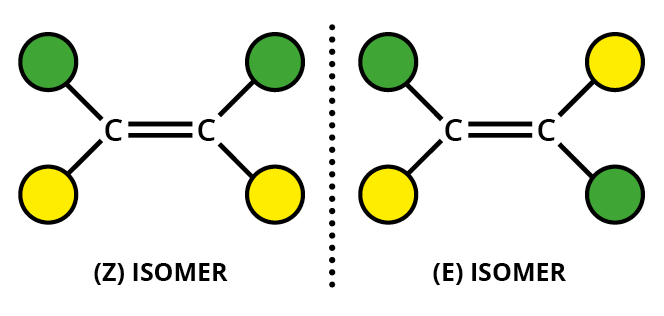E and Z
Key Questions
-
Answer:
#E-Z# isomerism occurs because there is restricted rotation about double bonds.Explanation:
In
#E-Z# isomers you must have:- restricted rotation, often involving a
#"C=C"# double bond - two different groups on one end of the bond and two different groups on the other end.
For example, an alkene such as but-2-ene has two different groups on each alkene carbon.
It can exist as
#E-Z# isomers that differ in the positions of the substituents on the double-bonded atoms.
The substituents can be given "priorities", with atoms with higher atomic numbers given higher priorities (the Cahn-Ingold-Prelog rules).
If the highest priority groups for each carbon are on the same side of the molecule, we have the
#Z# isomer.If the highest priority groups for each carbon are on opposite sides of the molecule, we have the
#E# isomer.
- restricted rotation, often involving a
-
Answer:
#E-Z# isomerism is a type of stereoisomerism that exists because of restricted rotation about double bonds.Explanation:
In stereoisomers, the atoms are joined in the same order, but they have a different spatial arrangement.
In
#E-Z# isomers you must have:- restricted rotation, often involving a
#"C=C"# double bond - two different groups on one end of the bond and two different groups on the other end.
An alkene such as but-2-ene has two different groups on each alkene carbon.
It can exist as
#E-Z# isomers that differ in the positions of the substituents on the double-bonded atoms.
The substituents can be given "priorities", with atoms with higher atomic numbers given higher priorities (the Cahn-Ingold-Prelog rules).
If the highest priority groups for each carbon are on the same side of the molecule, we have the
#Z# isomer.If the highest priority groups for each carbon are on opposite sides of the molecule, we have the
#E# isomer.
One way to remember the designations is to think of
#Z# as Zame Zide (same side).Since
#"CH"_3# has higher priority than#"H"# , it is pretty easy to determine that the butene isomers above are#E# and#Z# , respectively.But what about the isomers of 2-methylbut-2-enoic acid (below)?

#"CH"_3# has higher priority than#"H"# , and#"COOH"# has higher priority than#"CH"_3# .Angelic acid has the higher priority groups on the same side, so it is the
#Z# isomer.Tiglic acid has the higher priority groups on opposite sides, so it is the
#E# isomer. - restricted rotation, often involving a